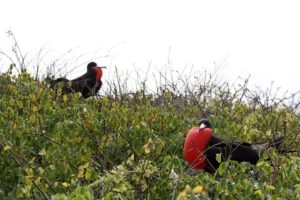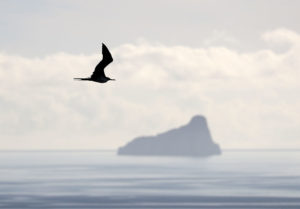I had an opportunity, at the Galapagos Archipelago, of watching, on several occasions, the habits of this bird … The Frigate bird has a noble appearance when seen soaring in a flock at stupendous height (at which time it merits the name of the Condor of the ocean), or when many together are dashing, in complicated evolutions, but with the most admirable skill, at the same floating object.
Charles Darwin, Zoology of the Voyage of the Beagle, 1841
The first day on San Cristobal, I noticed sleek, angular silhouettes soaring effortlessly high above Shipwreck Bay. When I asked one of the researchers what they were, she responded without looking up, betraying just a hint of annoyance, “They’re Frigatebirds.”And then, near the end of my time on the islands I was having lunch with two colleagues, discussing our impressions of the wildlife. When the subject of Frigatebirds came up, they chimed in unison, “We hate them.” One of them added in case there was any doubt, “Passionately.”
I’m not certain what they did to deserve such bile. After all, Darwin, who was not shy about slandering other species on the islands, spoke of them with admiration.The Magnificent Frigatebird (Fregata magnificens) that frequents San Cristobal has narrow, sweeping wings and a forked tail, giving it the appearance high in the sky of a black kite near the end of its string. Their wingspan is more than eight feet, enabling them to soar for hours at a time with little effort. They patrol the coast from dawn to dusk, returning to perch in the scraggly trees that cling to the edge of the cliff at Cerro Tijeratas, or “Frigatebird Hill”.
Males are an iridescent black, except for a small red patch on their throats that inflates into a bright balloon when they are courting. Females, seemingly much more common near Tijeretas, are black with white breasts and patches on their shoulders. Their long, narrow beaks have a hook at the end. They are an endemic subspecies of the Galapagos. The smaller Great Frigatebird (Fregata minor ridgwayi) visits San Cristobal but is more common on North Seymour and other islands.
Frigatebirds are not able to generate the oil in their feathers that enables other birds to dive into the water or float on the swells. They only dip their beaks or talons into the water when fishing. At El Junco in the highlands, we watched a flock of Frigatebirds swoop down to the water, splash lightly and then return to altitude before executing a kamikaze dive, feathers all askew, pulling up at the last minute. They went through the same motions, one after the other, apparently using the freshwater to wash the salt off their feathers and then drying themselves in the wind.Frigatebirds are often referred to as pirates because of their habit of stealing food from Boobies and other seagoing birds. They use their exceptional maneuverability to chase down other species, often pulling on their tails to get them to disgorge their last meal. They then break off, swooping down to grab their meal before it reaches the water.
The classic pose of the Frigatebird is the male with its puffed out red breast, issuing a shrill mating call. During this courtship ritual it looks as if it is holding a large balloon under its chin. As I rode in a boat along the north shore of San Cristobal one morning, I saw dozens of Frigatebirds perched in the short trees near the beach, all puffed out and looking hopeful.


